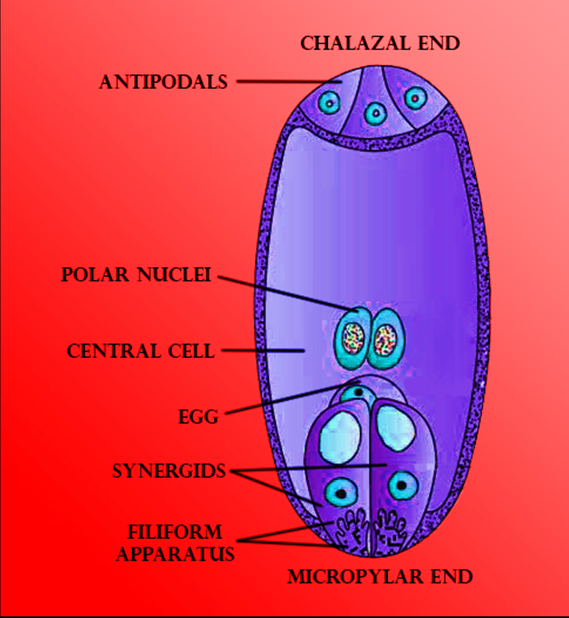
In embryo sac, n, 2n, 3n conditions are found respectively in
(a) egg, antipodal, and endosperm
(b) nucleus, endosperm, and egg
(c) antipodal, zygote and endosperm
(d) endosperm, nucleus, and egg
Answer
585.9k+ views
Hint: The first part of the answer provides nourishment to the egg cells. The second part of the answer is the immediate product of fertilization in an organism. The third part of the answer provides nourishment to the embryo.
Complete answer:
In embryo sac, n, 2n, 3n conditions are found respectively in antipodal, zygote, and endosperm. In a majority of flowering plants, one of the megaspores remains functional while the other three degenerate. Only the functional megaspore then develops into the female gametophyte or ‘embryo sac’.

When we observe the distribution of cells inside the embryo sac, we come to know that:
- There is a large central cell.
- At the micropylar end, 3 cells are grouped together to form an egg apparatus. The egg apparatus, in turn, consists of two synergids and one ‘egg cell’.
- Three cells at the chalazal end are together called ‘antipodals’. They are haploid.
Now, during double fertilization one of the male gametes moves towards the egg cell and fuses with its nucleus thus completing the ‘syngamy’. This results in the formation of a diploid cell, which is named as ‘zygote’.
While the other male gamete moves towards the two polar nuclei located in the central cell. Here, a fusion occurs among them to form a triploid ‘primary endosperm nucleus’ (PEN). As this process involves the fusion of three haploid nuclei, it is called ‘triple fusion’.
So, the correct answer is, ‘antipodal, zygote, and endosperm’.
Note:
-Each ovule has one or two protective envelopes. These are called integuments.
-Integuments encircle the nucellus from all the sides except at the tip where a small opening called the ‘micropyle’ is organized.
-Opposite the micropylar end, is the ‘chalaza’. It represents the basal part of the ovule.
-Since two types of fusions, syngamy and triple fusion take place in an embryo sac the whole phenomenon is termed ‘double fertilization’. This event is unique to flowering plants.
Complete answer:
In embryo sac, n, 2n, 3n conditions are found respectively in antipodal, zygote, and endosperm. In a majority of flowering plants, one of the megaspores remains functional while the other three degenerate. Only the functional megaspore then develops into the female gametophyte or ‘embryo sac’.

When we observe the distribution of cells inside the embryo sac, we come to know that:
- There is a large central cell.
- At the micropylar end, 3 cells are grouped together to form an egg apparatus. The egg apparatus, in turn, consists of two synergids and one ‘egg cell’.
- Three cells at the chalazal end are together called ‘antipodals’. They are haploid.
Now, during double fertilization one of the male gametes moves towards the egg cell and fuses with its nucleus thus completing the ‘syngamy’. This results in the formation of a diploid cell, which is named as ‘zygote’.
While the other male gamete moves towards the two polar nuclei located in the central cell. Here, a fusion occurs among them to form a triploid ‘primary endosperm nucleus’ (PEN). As this process involves the fusion of three haploid nuclei, it is called ‘triple fusion’.
So, the correct answer is, ‘antipodal, zygote, and endosperm’.
Note:
-Each ovule has one or two protective envelopes. These are called integuments.
-Integuments encircle the nucellus from all the sides except at the tip where a small opening called the ‘micropyle’ is organized.
-Opposite the micropylar end, is the ‘chalaza’. It represents the basal part of the ovule.
-Since two types of fusions, syngamy and triple fusion take place in an embryo sac the whole phenomenon is termed ‘double fertilization’. This event is unique to flowering plants.
Recently Updated Pages
The number of solutions in x in 02pi for which sqrt class 12 maths CBSE

Write any two methods of preparation of phenol Give class 12 chemistry CBSE

Differentiate between action potential and resting class 12 biology CBSE

Two plane mirrors arranged at right angles to each class 12 physics CBSE

Which of the following molecules is are chiral A I class 12 chemistry CBSE

Name different types of neurons and give one function class 12 biology CBSE

Trending doubts
One Metric ton is equal to kg A 10000 B 1000 C 100 class 11 physics CBSE

What is 1s 2s 2p 3s 3p class 11 chemistry CBSE

Discuss the various forms of bacteria class 11 biology CBSE

State the laws of reflection of light

Explain zero factorial class 11 maths CBSE

An example of chemosynthetic bacteria is A E coli B class 11 biology CBSE




